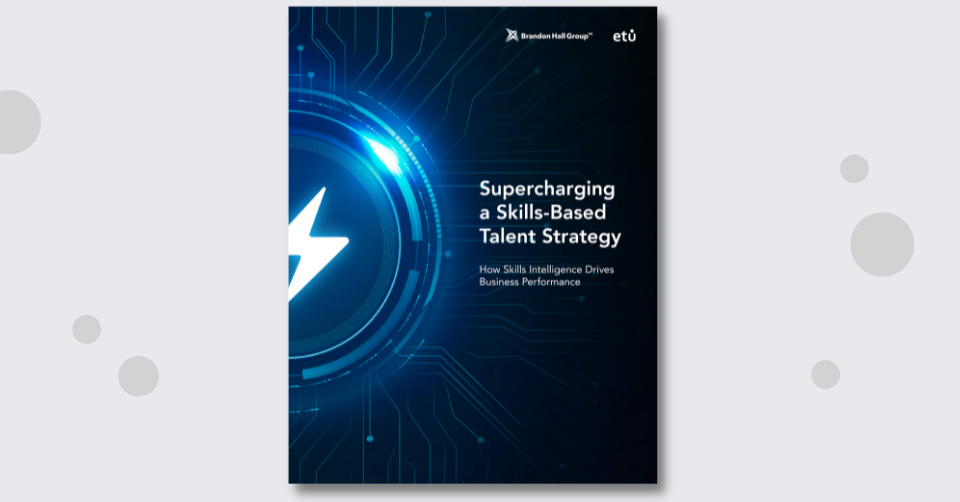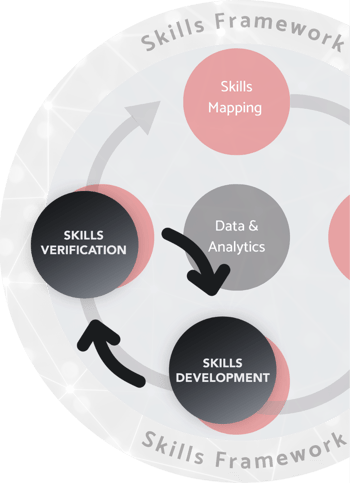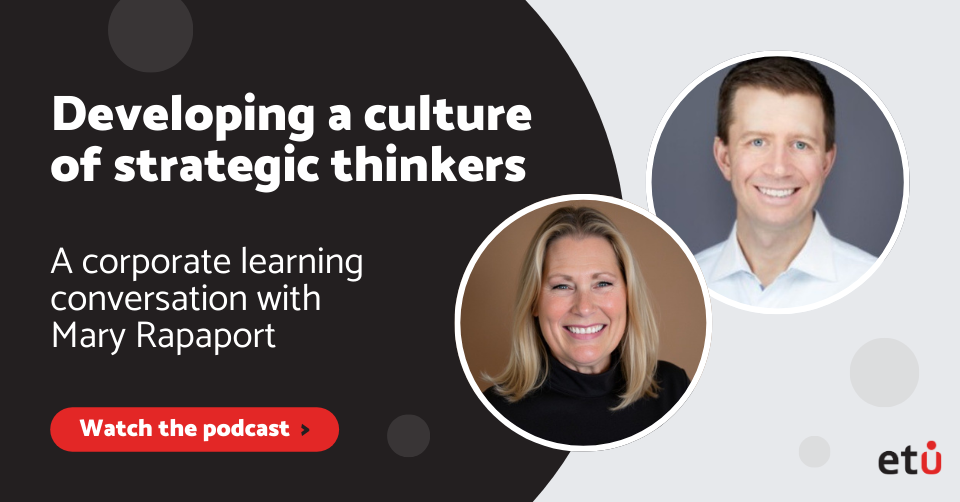
Skills Intelligence: Supercharging a skills-based talent strategy
Skills intelligence delivers powerful workforce insights to build business agility and resilience for the future. This eBook, co-authored with Brandon Hall GroupTM, provides a blueprint for improving business performance by supercharging your skills-based talent strategy.
A skills-based talent strategy
In our rapidly changing world, the traditional approach to developing skills, based on role and hierarchy, must evolve. The key to driving business performance is a skills-based talent strategy, which improves organizational agility and keeps companies competitive.
In their quest for a more skills-based approach, employers have often focused on technical and role-specific skills, but many of those will likely be replaced — or at least impacted — by AI and automation. A future-oriented, skills-based talent strategy should focus on “power skills” — also sometimes referred to as soft skills or critical skills. They include emotional intelligence, communication, decision-making, critical thinking, design thinking and even data storytelling skills. These are human-centric skills far less likely to be impacted by AI. They are also transversal across the organization, so improvements in these skills can have a big impact on business performance.
Source: Brandon Hall GroupTM Study, Transforming Learning and Development for the Future of Work
The move from role-based to skills-based organizations is well underway across all industries, but is more a marathon than a sprint. A skills-based strategy requires skills intelligence, which is based on a skills framework and comprises skill mapping, assessment, development and verification. Proficiency in these areas remains elusive for many organizations. It is vitally important, however, because a skills-based strategy built on skills intelligence will deliver important business outcomes, including:
- Growing the talent pools you need
- Increasing organizational agility
- Improving engagement and talent retention
- Making learning more effective
- Improving diversity and inclusion
The power of skills intelligence
Skills intelligence has become a critical tool for organizations looking to align their workforce capabilities
with strategic business objectives. As Brandon Hall Group research shows, many organizations are challenged to identify and develop the skills the business requires now and in the future.
Source: Brandon Hall GroupTM Study, Transforming Learning and Development for the Future of Work
What is skills intelligence?
It starts with a skills framework as its foundation. It then leverages skills mapping together with advanced skills analytics to provide insight into the current and future skills supply and demand within an organization. This intelligence empowers leaders to make more informed talent decisions around recruiting, development and workforce planning.
Skills intelligence also improves organizational agility and resilience. By understanding the skills gaps that
exist today and anticipating future needs, learning and HR leaders can take proactive steps to upskill
and reskill employees. This ensures the workforce is equipped with the competencies required to meet
evolving business goals and priorities. Skills intelligence provides the necessary capability to pivot, upskill
and redeploy talent quickly when conditions change.
Skills framework
A robust skills framework is the cornerstone for building skills intelligence capabilities. In our model, it is a foundational layer to the concept of skills intelligence, underpinning the whole strategy. It provides a standardized taxonomy of all the strategic skills required for the organization’s business objectives, both current and future-looking, and enables creation of a consistent skills language across the enterprise. With this structure in place, an employer can accurately map proficiency levels across the workforce for each skill. Gaps become visible. The skills framework also enables optimizing other talent processes from recruiting to learning to succession planning by tying them directly to business-aligned skills needs. A dynamic skills library can even empower employees to drive their own development and career mobility by seeing which skills are valued and sought-after.
Data and analytics
Data and analytics are at the center of the skills intelligence model because they provide real- time visibility into the current and future skills supply and demand within an organization.
To enable skills intelligence, employers must bring together diverse talent data sources like learning management systems, HR information systems, and performance management platforms into a central skills database. This provides a single source of truth.
Robust analytics can then extract insights into workforce skills proficiencies, gaps and future needs. Care must be taken to ensure consistent data taxonomy, integrity and governance across systems. However, many learning and talent organizations lack people with the necessary data and analytics skills; improvement is high on most employers’ priority lists.
Skills mapping
Skills mapping creates a comprehensive taxonomy of the capabilities required for an organization’s current and future business objectives and is central to establishing a strategic skills framework.
This enables systematically assessing the workforce’s current proficiency across each mapped skill to identify precise gaps. The skills taxonomy also allows for optimizing talent processes like recruiting, development and succession planning by tying them directly to the organization’s priority skills. Ongoing validation ensures the skills framework evolves along with business strategy.
Innovation in skills assessment
Organizations can only manage what they measure, so it is important to effectively assess and measure skills. The accuracy and validity of skills-related data determine the quality of the skills intelligence and support the overall transformation to a skills-based organization.
Existing approaches to skills measurement often lack assessment of skills proficiency before training and focus only on knowledge transfer after training. Often, the level of skills application is also overlooked. While there has been some progress over the past two years, according to Brandon Hall Group research, only about one-quarter of organizations believe they are proficient.
Source: Brandon Hall Group Study, Think Like a CEO: How Learning Drives Business Impact
The shift to a skills-based talent strategy requires a transformation of assessment. There are two possible methods that can be used to assess employee skills:
- Technology-driven: AI-powered tools can automate the skills assessment process by analyzing data from various sources, including resumes, job applications, performance evaluations and online profiles. For power skills, immersive learning methods can assess employees’ ability to apply power skills. The technology simulates workplace scenarios and assesses how proficient the learner is in each skill.
- People-driven: Employees or job candidates can self-identify their skills through skills assessment surveys during a skills-mapping exercise. They can also create skills portfolios showcasing applied skills and engage in self-reflection to identify current skills and growth areas. Manager input can also be elicited through performance appraisals, feedback sessions and other processes. Encouraging employees to participate in the process fosters a more accurate and comprehensive skills inventory within the organization.
Progressive organizations combine approaches, where technology first does the heavy lifting to pre-populate skills data. Then, skills identified by employees, job candidates or managers can be overlayed or integrated.
“It's fascinating to me just how fast the technology is going. It's almost faster than you can make the decisions. And so that's been one of our challenges, in particular on the AI side of it.”
Talent Leader, diversified industrial organization
Skills proficiency
Identifying skills is only a first step. To make talent decisions, you must know how proficient employees are. Is an identified skill rarely applied? Or has the employee demonstrated some competence, but still requires some guidance? Or are the people you are evaluating fully competent and can demonstrate expertise?
“What might seem straightforward starting the process, becomes more complex as you dive in. This is especially true of power skills. For example, what does ‘strategic agility’ really mean, and how do you set about measuring proficiency in it?”
Talent Leader in a services organization
Technology tools are getting quite advanced at identifying skills, but still need to improve at making proficiency decisions. People, either employees or managers, are better at assessing proficiency, but it is challenging to do this at scale and precision for a wide range of skills. Skills tests and assessments can work well for verification, but traditional testing methods can be limiting.
“Unless you're doing it (applying skills on the job), then you're probably not as professional as you thought you were. We've got people who are data scientists with PhDs but they haven't really been doing data science work for some years.”
Talent Leader, media organization
The advantage of simulations
We are seeing new methods fill this gap, combining the scale advantages of technology and the accuracy of people. One such approach is simulation, where employees are put in realistic business situations where
they are actively making decisions. Their observed behaviors are then automatically assessed by the skills needed to navigate the simulation. Simulation providers such as ETU have run trials with industrial / organizational psychologists to confirm the validity of the measurement. Simulations can be used to assess skill proficiency before and after training to understand the increase in applied skill proficiency.
Precision skill development
In role-based skills development, learning tends to focus on broad courses that cover many skills and capabilities that a specific job or role requires. This approach lends itself to knowledge acquisition, but not to practical application.
In a skills-based talent strategy, learning should be based on assessment results and allow learners to practice skills and apply them to real workplace situations. For example, take development of critical thinking, one of the important “power skills” necessary for people to thrive in a digital workplace where AI and automation are expanding.
An employee may first complete online lessons on critical thinking techniques like asking probing questions and identifying assumptions. They may then go through a simulation that requires the learner to apply the skills in a challenging situation. The simulation provides in-the-moment coaching and encourages reflection and deeper learning. Learners showing mastery in the simulation might regroup in an in-person workshop on more complex case studies.
Over time and through different learning contexts, the learner gains proficiency in facilitating critical thinking that ultimately enhances their team’s decision-making.
Precision also means personalized learning. Organizations must offer options for learners to acquire skills based on their existing skill levels. All employees have some existing skills in power skills. They also have gaps where they need development and some areas where they are already well proficient and don’t need unnecessary training.
Skills verification
The biggest missing link in the traditional approach to learning measurement is verification of skills application. Brandon Hall Group research shows that only 35% of organizations measure how knowledge and skills are being applied by learners on the job or in simulated job scenarios.
Technology is a great enabler of measuring and verifying skills proficiency. This includes understanding any remaining gaps and designing initiatives to reduce or eliminate those gaps.
Here are a few ways AI and other emerging technologies can be leveraged to measure and verify skills proficiency:
- Knowledge tracing through learning management systems uses AI to understand the concepts employees have mastered based on training content interaction and assessment performance. This provides data on current knowledge levels only.
- Simulations and virtual environments are playing an increasing role in skill verification for power skills in addition to their role in precision skills development. Immersive learning provides both the objectivity and scale needed. They also allow more dynamic skill measurement. By embedding power skills in multiple simulation experiences, skills intelligence is available on performance over time.
- Natural language processing techniques can analyze workplace documents and communications to extract evidence of proficiency in soft skills like communication, collaboration and critical thinking.
Skills feedback loop

The key benefits of using AI and emerging technology for skills assessment include objectivity, continuous measurement and removal of bias. Organizations get an accurate, real-time view of workforce competencies critical for agile decision-making.
But what happens if your measurement shows that skills are not being applied at the expected or required proficiency? In that case, there must be a feedback loop in which a learner is informed of a remaining skills gap. That leads to another round of skills development aimed specifically at the skill gap(s). The loop should continue until all proficiency targets from the learning initiative are met.
Conclusion and takeaways
A skills-based talent strategy is critical to prepare the workforce for the future. The strategy must be centered around skills intelligence because employers can’t develop talent unless they understand the skills that reside in their workforce and the gaps they need to fill. From there, you can close the loop by assessing and developing proficiency through dynamic and personalized learning aligned with the types of skills you are attempting to improve.
As you get started on your journey with skills intelligence, here are some important considerations as you evolve your skills-based talent strategy:
- Validate your skills framework. Ensure the taxonomy evolves along with business objectives through regular review and stakeholder input.
- Scale strategically. Many organizations struggle or fail to develop skills intelligence because they try to do too much, too fast. Acquiring skills intelligence is complex. It’s important to start small and scale as you gain experience and insight.
- Focus on impact. Assess skill levels before learning initiatives and personalize the experiences to the employee’s needs. This precise type of learning leads to more impact for the learner and for the business.
- Empower employees. Communicate the importance of power skills across the workforce so employees understand how they can drive their own development and career mobility.
- Deliver behavior change. Behavior change requires space for skills application, practice, and reflection. Use new technology to help you scale.
- Make skills data a strength. Having data as a single source of truth is critical to a skills-based talent strategy. Leverage new approaches to skill verification for better talent decisions.
- Knock down silos. Cross-functional collaboration brings a holistic view of skills needs and strengthens adoption.
- Communicate progress. Share skills intelligence successes, use cases and metrics to sustain engagement. Celebrate success!

